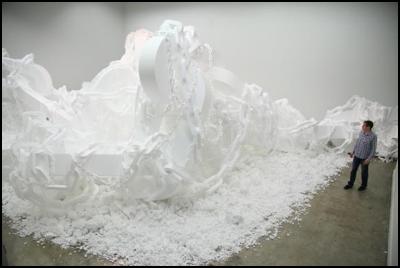Bumper crowds for Snow Ball Blind Time
Bumper crowds for Peter Robinson: Snow Ball Blind Time

Click to enlarge
Image: Peter Robinson Snow Ball Blind Time 2008 Govett-Brewster Art Gallery
Media Release
23 October 2008
Bumper crowds for Peter Robinson: Snow Ball Blind
Time
13 September - 23 November 2008
The Govett-Brewster Art Gallery’s highly anticipated spring exhibition, Peter Robinson: Snow Ball Blind Time has snowballed in popularity among gallery visitors and critics alike.
Since the opening a month ago more than 6000 visitors have attended the exhibition.
“Awe-inspiring” incredible”, “viral”, “courageous”, “mind blowing” are just a few of the most frequently used words to describe the exhibition with many visitors spending well over an hour in the exhibition space.
More than 65% of visitors to the gallery have come from outside the New Plymouth district, while 13% are from overseas. Exhibition numbers are 50% higher than the same period last year.
Gallery director Rhana Devenport says “this is significant for Taranaki and highlights the pulling power of the Govett-Brewster’s exhibition programme and its ability to surprise.”
“Local, national and international audiences of all ages have whole-heartedly connected with this show, while international interest has also been keen”, says Devenport.
The exhibition is also proving immensely popular with school groups. Gallery education staff are taking as many as four classes per day.
Simon Bowden,
Executive Director of the NZ Arts Foundation says in
response to the exhibition “this is a great moment in New
Zealand art history.” Some say this is the most impressive
single large scale installation they have ever seen at the
gallery while many others have articulated this exhibition
as the “must see show of the year”.
Curated by
Gallery Director, Rhana Devenport, Snow Ball Blind
Time is Peter Robinson's most recent and expansive
project, commissioned by and presented at the
Govett-Brewster Art Gallery.
Snow Ball Blind Time occupies the entire 574 square metres of the Gallery. The installation responds to and engages with the Gallery's seven interconnecting internal spaces to form a vast spatial drawing. This is only the second time since the opening exhibition in 1970 by Leon Narbey that the entire Gallery has been offered to an artist in a single commissioned work.
The use of expanded polystyrene foam as a material is something that Robinson has interrogated over recent time, however his work has taken a significant shift in direction since late 2006 (ACK at Artspace, Auckland), seen in a series of exhibitions in Auckland, Berlin, Christchurch, Melbourne, Sydney and Wellington.
Peter Robinson was born in Ashburton, Canterbury in 1966, and lives and works in Auckland. He is currently Associate Professor at the Elam School of Fine Arts, National Institute of Creative Arts and Industries, University of Auckland. He has held artist residencies in Aachen, Düsseldorf, Berlin and Sydney and guest lectureships in the US, Sweden and Denmark. Exhibitions include the 8th Baltic Triennale of International Art, Vilnius and 'Iconoclash' at ZKM, Karlsruhe in 2002; 'bi-polar', 49th Venice Biennale, New Zealand Pavilion in 2001; Biennale of Sydney in 1998; the 2nd Johannesburg Biennale in 1997; and 'Steirischer Herbst 96: Inklusion-Exklusion, Künstlerhaus, Graz, Asia-Pacific Triennial, Brisbane and Bienal de São Paulo in 1996. Robinson is a current finalist for the 2008 Walters Prize the premier contemporary art award for outstanding contribution to contemporary art in New Zealand.
Snow Ball Blind Time will soon be accompanied by a publication that documents projects between ACK (2006) and Snow Ball Blind Time and includes new texts by Allan Smith (curator, critic and Senior Lecturer at the Elam School of Fine Arts, Auckland, New Zealand), Rachel Kent (Senior Curator, Museum of Contemporary Art, Sydney, Australia) and Rhana Devenport (Director, Govett-Brewster Art Gallery, New Plymouth, New Zealand).
ENDS
The artist acknowledges the support of
the National Institute of Creative Arts and Industries
(NICAI) Research Development
Fund


 Hospice NZ: Sustainable Funding For Hospices
Hospice NZ: Sustainable Funding For Hospices David Hill - LDR: Surge In Young Parents’ College Enrolments
David Hill - LDR: Surge In Young Parents’ College Enrolments NZEI Te Riu Roa: School Lunches - Give Schools Option To Use In-School And Community Providers Immediately, Union Says
NZEI Te Riu Roa: School Lunches - Give Schools Option To Use In-School And Community Providers Immediately, Union Says University of Auckland: Billion-dollar Business Lessons From Kiwi Entrepreneur
University of Auckland: Billion-dollar Business Lessons From Kiwi Entrepreneur NZ Veterinary Association: NZVA Celebrates Welcome Additional Support From Veterinary Nurses
NZ Veterinary Association: NZVA Celebrates Welcome Additional Support From Veterinary Nurses Michael King Writers Centre: New Zealand’s National Writer-Residency Organisation Announces Its 2025 International Residency With Australia
Michael King Writers Centre: New Zealand’s National Writer-Residency Organisation Announces Its 2025 International Residency With Australia